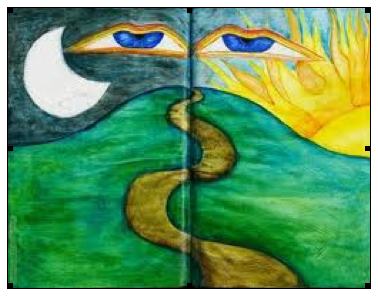The posture of yoga is steady and easy.
It is realized by relaxing one’s effort and resting
like the cosmic serpent on the waters of infinity.
Then one is unconstrained by opposing dualities.
Barbara Stoler Miller
Until I began to practice a “steady and easy” way of being in the world, I never truly understood how my rush to act was the source of struggle and limitation in my life. For the ten years in which yoga has been one of my spiritual rituals, I recognize my practice as being focused on getting more, faster — more strength, more flexibility, more health, more joy. Interestingly, this drive also resulted in more struggle and more limitation. Only recently have I succeeded in relaxing my effort and discovering the feel of restfulness. Of course, this awareness surfaced in the wake of an injury, fortunately a minor one, caused from pushing myself beyond steady and easy. I am thankful I could hear this voice of pain urging me to back off before greater damage occurred. In doing so, I gained an additional awareness about myself.

In my past, backing off meant stopping or ending a desired experience. There was no middle ground. Loss was always attached to either/or — either I ended an experience or I began a new one. My rush to action would immediately move me on to something new that caught my eye. Very little time, maybe none at all, was spent in releasing, resting and reflecting on the ‘old’ experience before I leaped into my next new endeavour. Frankly, it was exhausting mentally, spiritually and emotionally.
Today, as I practice backing off in my life and my yoga postures, I am taking the time to enjoy resting within each “like the cosmic serpent on the waters of infinity.” An added and unexpected delight was the accelerated healing of my injuries. Not only do I feel the “rightness” of the pose or the experience, but I feel happier, stronger and more flexible in the backed-off, resting place. So simple once I got my mind/ego out of the way.
The mind moves from one extreme to another, that is the way of the mind. So it happens
every day: a person who was mad after wealth renounces everything, becomes a naked
fakir. We think, “What a miracle!” But it is nothing — just the ordinary law. A person
who was not mad after wealth cannot be expected to renounce, because only from one
extreme can you move to another.
So a person who was after wealth, mad after wealth, will become mad against it, but the
madness will remain — that is the mind.
The extreme has a fascination for the mind. [. . .] Because in the middle, mind dies.
So this [yoga] sutra says, UNMINDING MIND, KEEP IN THE MIDDLE — UNTIL.
[. . .] the mind dies. . . . until there is no mind. If mind is at the extremes, then the
middle will be no-mind.
So try it. . . . and you will feel a certain calmness developing, a tranquility coming
to you, a quiet center growing within you.
Even if you are not successful in being exactly in the middle, try to be in the middle.
By and by you will have the feel of what middle means. Whatsoever may be the
case — hate or love, anger or repentance — always remember the polar opposites
and remain in between. And sooner or later you will stumble upon the exact middle
point.
Once you know it you can never forget it again, because that middle point is beyond
the mind. That middle point is all that spirituality means.
(adapted from: Unminding Mind, Keep in the Middle — Until., Vigyan Bhairav Tantra).
I would further suggest the ‘middle point’ is a metaphorical reference to our spiritual centre. When I listen to my spiritual centre which is rooted in my body, I express the steady ease of the middle way. Initially I discovered this during the writing of my first book, Creating Space — The Practice of Transformation. Writing that book, not unlike practicing yoga, refined my experiences as well as my ability to express them. Refinement moves us out of the crudeness of extremes into the subtleties and accuracy of a purer experience — the middle way. To achieve this subtlety, we must become aware of and utilize our own centre. I find it quite marvellous; this ability to come upon an unknown during writing, yoga or life in general, ask a question and receive an answer from the stillness within. So simple, so subtle and so joyfully miraculous.
Going within first, then responding outward ensures I react from my spiritual centre or authentic self. This practice of the “middle way” establishes a solid inner foundation of truth and wisdom where certainty in choosing becomes a constant rather than fleeting aspect in my life. First seeking my centre allows me to choose the truth, beauty and goodness of both extremes rather than be impulsively controlled by one or the other. Over time and with practice, we transcend the limits of our physical experience by responding not from our ego but from our spiritual centre where all extremes are integrated/united.
What extreme behaviours are you expressing in your life —
• over-cooperating or competing?
• bingeing or starving?
• rescuing or taking?
• striving or thriving?
• stressed or blessed?
Ask yourself, “Where am I exhibiting extremes? What step can I take toward middle ground?”




